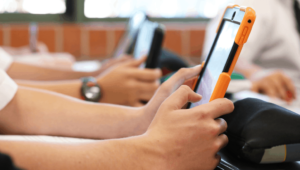How Digital Literacy Impacts Today’s Classroom

Every day, students are bombarded by endless media messages. From ads on YouTube videos to peer-to-peer communication on social networks, students are constantly exercising their ability to process and respond to technological communication in a nanosecond.
Digital literacy provides the framework to teach students appropriate ways to interpret the constant influx of information. Accessing, analyzing and evaluating media are essential skills, and will only become more imperative in a world that is making the shift towards increasingly prevalent and sophisticated technological automation.
Digital literacy is also important for the creation of media. Presentations requiring students to be technologically literate continues to be a requirement throughout education, whichever standard one goes by. New guidelines state that educators need to “make strategic use of digital media and visual displays of data to express information and enhance understanding of presentations.”
This includes having students create their own presentations using technologies like PowerPoint, Prezi or eMaze, creating or viewing graphs in Excel and teaching critical data analysis. All of these skills fall under the umbrella of digital literacy and are an observation point that administrators are sure to look for in teachers’ lessons.
Cyber Citizenship
Additionally, students should be taught to be responsible cyber-citizens, much like they’re taught to be appropriate and responsible in their “real” lives. Similar to raising children in the physical world, educators have the unique opportunity to make sure students know how to navigate the internet safely, to protect themselves from predation or trolling and to not abuse the genre by becoming a cyberbully.
As with any tool or skill that children learn, there needs to be a framework wherein they understand the limitations, danger zones and pitfalls that are inherent in it. Digital literacy is not just a user manual or a how-to guide–it is also a system of ethics and civic-minded behaviors that hopefully will guide young technology gurus as they grow. Luckily technology, such as this Digital Citizenship program from Learning.com, can also help teachers help students as they develop their digital literacy skills.
Digital Literacy Resources
Thankfully, many digital tools have been developed in recent years that are easy for both teachers and students to use. They also serve to engage students in their own path of learning and end up often going beyond what is required by the particular unit of instruction.
One of these useful edtech options is ReadWorks, which provides age and skill-level appropriate articles and reading material for students. The article-a-day feature allows students to absorb background information about history, fun facts and culture. Teachers can then use this as an opportunity to teach students to mindfully read media online by asking students to analyze what they see. Does the source seem reliable? What is the image telling you about who the intended audience is?
Any time a child accesses the internet, they are inundated with countless news articles and opinions. Online reading and article software like ReadWorks can teach students to filter, decipher and analyze the components of quality scholarship and news.
Another useful edtech option is Voki, an app that guides children on how to properly represent themselves digitally. Students create unique digital avatars and then use them to create a digital representation of themselves in classroom presentations and communication with their teacher. This gives students a user-friendly way of learning technology that they have not been exposed to in the past and allows teachers the opportunity to correct and guide them towards more sophisticated and acceptable digital behavior. It also encourages non-verbal students to have a voice in the classroom and helps them feel confident that their contributions are valued and important.
This gives students a user-friendly way of learning technology that they have not been exposed to in the past and allows teachers the opportunity to correct and guide them towards more sophisticated and acceptable digital behavior. It also encourages non-verbal students to have a voice in the classroom and helps them feel confident that their contributions are valued and important.
While the task of teaching students digital literacy can be daunting, it has essentially become a necessary part of today’s learning. Teachers and parents can embrace the opportunity to be digital role models and leaders for students, and provide monitored outlets for them to practice digital literacy in a safe and protected space.
For more, see:
- Making Their Own Learning: Students Review Two Helpful Apps
- 4 Apps that Bring Daily Classroom Activities into the 21st Century
- 10 EdTech Tools for Encouraging Classroom Collaboration
Na’ama Y. Rosenberg is a former educator, school administrator and is currently the Director of Content Development at Voki. Follow them on Twitter: @OfficialVoki
Stay in-the-know with all things EdTech and innovations in learning by signing up to receive the weekly Smart Update.





John Modupe
This is so great I love this